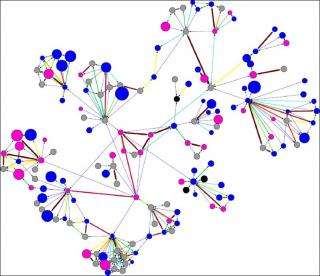April 22, 2008 weblog
Physicists investigate 'best friends forever'

Some friendships are short and fleeting, while others may last years. Although a wide variety of factors go into determining the strength of our relationships, the long-lasting ones seem to share a number of the same characteristics, according to a recent study.
Using data from nearly 2 million people and 8 million phone calls over the course of a year, physicist Cesar Hidalgo from the University of Notre Dame and sociologist Carlos Rodriguez-Sickert from the Pontifical Catholic University of Chile have investigated the persistence of relationships within the cell phone network. Somewhat intuitively, they found that the leading cause of persistent relationships is reciprocity - returning a friend´s call. Further, they could use these characteristics to predict the nature of relationships in the future.
As the researchers explain in their study, the persistence of the connection between two individuals is a measurement of how often they call each other. The scientists analyzed 15-day intervals, and determined if the two callers made contact within each interval. The greater number of these chunks of time in which contact occurred, the higher the pair´s persistence value was.
The scientists found that the majority (60%) of ties between two callers lasted for just one 15-day interval. The next 20% of ties disappeared slowly throughout the course of the year, and the remaining 20% persisted for the entire one-year period.
The results showed that the strongest factor determining persistence values was when individuals returned calls to each other. When links were reciprocated, those links had a greater chance of persisting for longer time periods. Also, when an individual´s connections had connections among themselves (when a person´s friends knew each other), his or her own connections lasted longer. The results also revealed insight into "social butterflies" - individuals with a high number of links.
"One result that I thought was somehow not so intuitive was the trade-off between the degree (number of links) of a person and the persistence of its ties," Hidalgo told PhysOrg.com. "It has been known for a long time that some people are much more connected than others, yet it was not known whether these highly connected individuals also had a larger number of strong connections. While time constraints may force people with more ties to be less persistent on average, the data also showed that, in absolute terms, people with more ties also have a greater number of persistent ties than those less connected. Highly connected individuals are not trading quality for quantity; rather, they appear to be more socially expressed in both the numbers of links and the persistence or strength of them."
By knowing the characteristics of persistence, the researchers could look at the features of the network for the first 15 days, and predict what the network would look like in the future. Since social connections play a role in areas such as collective decision making and consumption, predicting these connections might help researchers predict some of society´s actions. For example, measuring the persistence of a person´s social ties might open a new dimension for marketing segmentation strategies.
"One area which is interested in new ways of characterizing individuals is marketing," Hidalgo said. "To more effectively market their products, companies have traditionally segmented the targeted population by age, gender, ethnicities and socioeconomic status. As data on the social structure becomes increasingly available, it becomes possible for companies to categorize people based on their local structure on the social network.
"This opens a new layer of information that cannot be accessed otherwise. The social structure surrounding an individual is likely the result of its behavior and personality, hence is likely to carry more relevant information than its age and gender. The persistence of a person´s social relationships is a dynamical measure that can be used to tell us how strongly a person is connected to its peers. It could indicate a level of respect or authority that cannot be captured by purely structural measures, such as the number of links or the density of its social structure."
More information: Hidalgo, Cesar A. and Rodriguez-Sickert, C. "The dynamics of a mobile phone network." Physica A 387 (2008) 3017-3024.





















